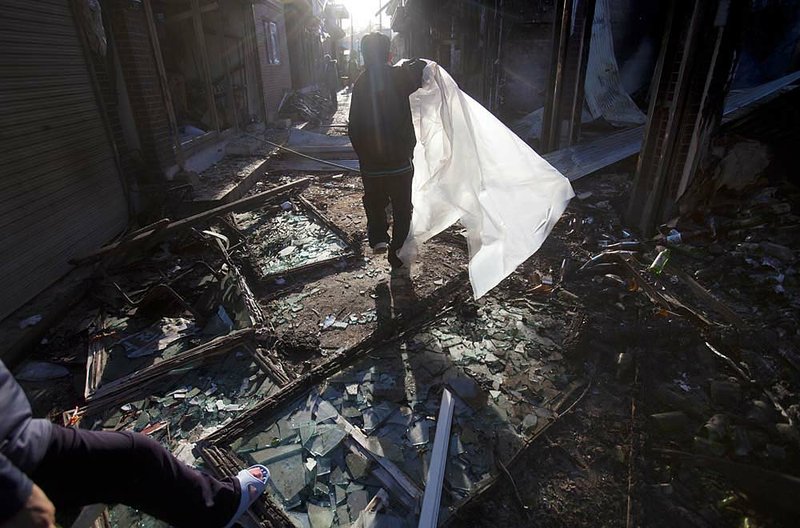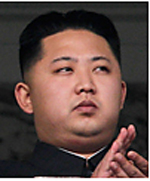YEONPYEONG ISLAND, South Korea — South Korean officials said Friday that artillery shots were heard on the Yellow Sea island attacked earlier this week by North Korea.
The South Korean Joint Chiefs of Staff said two explosive sounds were heard on Yeonpyeong island. A military official, speaking under conditions of anonymity, said officials were trying to figureout the circumstances.
It was not immediately clear if the artillery sounds were coming from North Korea or from the island.
The sounds came as the North warned Friday that U.S.-South Korean military drills planned for this weekend are pushing the peninsula to the brink of war, and after a U.S. military commander toured the wreckage of island communities devastated by a North Korean artillery barrage on Tuesday.
AP Television news reporters also reported a third blast.
Pyongyang’s state news agency said drills this weekend involving South Korean forces and a U.S. nuclear powered super carrier in Yellow Sea waters south of Tuesday’s skirmish between the rival Koreas amount to a reckless move to target the North.
“The situation on the Korean peninsula is inching closer to the brink of war,” the dispatch from the Ko-rean Central News Agency said. “Gone are the days when verbal warnings are served only.”
North Korea’s army and people are “now greatly enraged” and “getting fully ready to give a shower of dreadful fire,” the agency said. “Escalated confrontation would lead to a war, and he who is fond of playing with fire is bound to perish.”
In a show of solidarity with ally Seoul, Gen. Walter Sharp, the U.S. military commander in South Korea, paid a visit Friday to Yeonpyeong island, where four people were killed by North Korea’s artillery barrage Tuesday.
Dressed in a heavy camouflage jacket and army fatigues and wearing a black beret, Sharp walked down a heavily damaged street strewn with debris from buildings. Around him were charred bicycles and shattered bottles of soju, a kind of Korean alcoholic drink.
Sharp said the attack was a clear violation of an armistice signed in 1953 at the end of the three-year Korean War.
Despite North Korea’s warnings that any new provocation would be met with more attacks, Washington and Seoul pushed ahead with plans for military drills starting Sunday.
Four South Koreans - two marines and two civilians - were killed in the hour-long skirmish Tuesday after North Korea unleashed a hail of artillery on Yeonpyeong, but the island was quiet this morning, with most residents having evacuated to the mainland.
Marines with M-16 rifles patrolled a seawall, while others gazed toward North Korea from a guard post on a cliff. Technicians worked to restore communication lines. Several stray dogs growled near destroyed houses.
The heightened animosity between the Koreas is taking place as the North undergoes a transition of power from leader Kim Jong Il to his son Kim Jong Un, who is in his late 20s and is expected to eventually succeed his ailing father.
South Korean President Lee Myung-bak has ordered reinforcements for about 4,000 troops on Yeonpyeong and four other Yellow Sea islands, as well as top-level weaponry for the soldiers and upgraded rules of engagement that would create a new category of response when civilian areas are targeted.
He also fired his defense minister amid intense criticism over lapses in the country’s response to the attack.
Dazed residents of Yeonpyeong island this week have foraged through blackened rubble for pieces of their lives and lugged their possessions down eerily deserted streets strewn with bent metal.
“It was a sea of fire,” resident Lee In-ku said Thursday, recalling the flames that rolled through the streets of the island that is home to military bases as well as a fishing community famous for its catches of crab.
The spit of land had only six pieces of artillery.
North Korea cited South Korean drills this week as the motivation behind its attack, but Lee said the South could not afford to abandon such preparations now.
“We should not ease our sense of crisis in preparation for the possibility of another provocation by North Korea,” spokesman Hong Sang-pyo quoted President Lee Myungbak as saying. “A provocation like this can recur any time.” Washington and Seoul also ratcheted up pressure on China, North Korea’s main ally and biggest benefactor, to restrain Pyongyang.
Without criticizing the North, Chinese Premier Wen Jiabao responded by calling on all sides to show “maximum restraint” and pushed again to restart the six-nation talks aimed at persuading North Korea to dismantle its nuclear programs in exchange for aid. Foreign Minister Yang Jiechi, meanwhile, canceled a trip to Seoul this week.
On Thursday, Lee accepted Defense Minister Kim Taeyoung’s offer to resign after lawmakers criticized the government, claiming that officials were unprepared for Tuesday’s attack and that the military response was too slow.
A commentary in the conservative South Korean daily Chosun Ilbo assailed Kim, saying the military had been outgunned and underprepared.
“The minister practically admitted that the military failed to respond to a new type of North Korean threat” in the Yellow Sea, the newspaper said, charging that “the military has been implementing reforms that weaken defense capabilities” on the islands.
Skirmishes between the Korean militaries are not uncommon, but North Korea’s bombardment of Yeonpyeong Island took hostilities to a new level because civilians were killed.
South Korean troops returned fire and scrambled fighter jets in response. Two South Korean marines and two construction workers were killed and at least 18 others wounded. South Korea has said casualties on the North Korean side were likely significant, but none were immediately reported by that country.
Marine Lt. Col. Joo Jongwha acknowledged that the island is acutely short of artillery, saying it has only six pieces: the howitzers used in Tuesday’s skirmish.
“In artillery, you’re supposed to move on after firing to mask your location so that they don’t strike right back at you,” he told reporters. “But we have too few artillery.” On Yeonpyeong, some spoke of walls of flame, surreal images of blackened skies, dust clouds and orange-colored lightning.
“My town was almost burned out,” said Noh Myungsan, 56, who was planting trees near a mountain when he heard artillery explosions. “I thought it was an earthquake.” Shin Sung-nam, 70, said the attack was worse than anything he’d experienced during the Korean War.
His 17-year-old grandson, Lee Sung-won, said he was taking an exam when the barrage started.
“I just saw something black was coming from the sky and hit the ground,” he said.
On the streets of Seoul, people drew comparisons between the attack and the war of the 1950s.
“This is scarier than the Korean War,” said Kim Hak-won, 74. “This is the first time I saw a village devastated by bomb shells.” Though North Korea regularly threatens to rain munitions down on its rival, the two Koreas are required to abide by an armistice signed in 1953 at the end of their three-year war.
North Korea does not recognize the maritime line drawn by U.N. forces and said South Korean military maneuvers near Yeonpyeong Island this week were a violation of its territory.
The disputed waters have been the site of three other deadly naval skirmishes since 1999. However, the most costly incident was the sinking of a South Korean warship eight months ago that killed 46 sailors in the worst attack on South Korea’s military since the war.
Later Thursday, Seoul officials reiterated that the North Korean leader had called for the attack. “This provocation was carefully coordinated and planned by Kim Jong Il. Any single gunshot by North Korea will be commanded by the Dear Leader and his third son,” a senior government official said.
Information for this article was contributed by Hyung-Jin Kim, Kwang-tae Kim, Seulki Kim, Kelly Olsen, Ian Mader and Jean H. Lee of The Associated Press; by Mark McDonald of The New York Times and by John M. Glionna and Ethan Kim of the Los Angeles Times.
Front Section, Pages 1 on 11/26/2010

